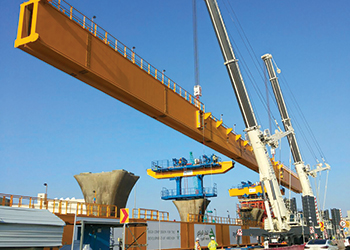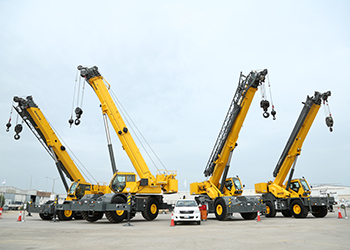-and-Mecca_Kudai-(4).jpg)
-and-Mecca_Kudai-(4).jpg) Dubai Burj Residence and Abraj Al Kudai in Makkah (right) ... Wolffran projects.
Dubai Burj Residence and Abraj Al Kudai in Makkah (right) ... Wolffran projects.
Wolffkran cranes can be seen working on many prestigious projects in the region – from the tallest buildings to those that hold religious sentimental value to millions.
Wolffkran cranes are engaged in many premier projects in the Mena (Middle East and North Africa) region with Saudi Arabia and the UAE being leading markets for the company in addition to Egypt and other Gulf states.
In Saudi Arabia, Wolffkran is involved in the expansion of the Grand Mosque in Makkah, where more than 100 cranes are deployed, while having contributed to the completion of Princess Nora University in Riyadh. The company has also helped in the completion of the Burj Khalifa in Dubai, the UAE.
Wolffkran is currently involved in construction of the highest skyscraper in the world, the Jeddah Tower (previously known as Kingdom Tower) in Saudi Arabia. Roots Group Arabia, exclusive agent for the German manufacturer, has supplied 11 cranes for construction of the kilometre-high tower being built in Jeddah by Saudi Binladin Group (SBG). Wolffkran is also supplying to the CMA Tower in Riyadh’s King Abdullah Financial District (KAFD).
On the Jeddah Tower site, nine Wolff 7532 saddle jib cranes are being used primarily for moving loads on the ground and construction of the podium at the tower base. A Wolff 355 B luffing crane with a 40-m jib and a maximum lifting capacity of 28 tonnes is also deployed.
Habib Mikati, managing director, Wolffkran, Middle East and North Africa, is in a confident mood as he surveys the market across the region from his offices in Tecom, Dubai. A mechanical engineer, who graduated from the American University of Beirut, Mikati first came to the Middle East from Lebanon in 1986 to work with Saudi Oger before moving to the UAE in 1987 to join the National Petroleum Construction Company (NPCC) in Abu Dhabi.
“At that time, NPCC was doing a lot of offshore work with McDermott and working on Saadiyat Island as well. I started with NPCC as plant and maintenance engineer. I have had a passion for cranes all my life and NPCC invested a great deal in me for additional training by the American Cranes (Terex) in Wilmington, North Carolina, as well as Manitowoc, P&H and Lorain and then later Demag and Kobelco,” says Mikati.
In 2000, Mikati moved to Kuwait to work in a combined managerial position with Kharafi National in its oil and gas division as plant manager. By 2008, Mikati had returned to the UAE to join Ejar Cranes in corporate fleet management and then taking the top job in Wolffkran Mena in 2014.
“Saudi Arabia is our largest market with the Dubai office covering Mena as our international sales and technical office on behalf of Germany. As an engineer, all my professional life I have had to get my hands dirty as I know the technical aspects from the weights, loads and stresses that have to be worked out,” he says.
“Now we have a team in Dubai and Saudi Arabia with two engineers stationed full time in the kingdom. We also rely on our exclusive partners such as Roots Group Arabia, which handles direct sales and rentals in Saudi Arabia as well as WKA (Wolffkran Arabia), which handles rentals in UAE and other countries within the GCC. In addition, we have full technical and managerial access to Wolffkran Germany from the Heilbronn and Luckau manufacturing plants,” he continues.
“I am very impressed by our partners and their accumulated technical expertise and as an engineer, I understand the level of technical competencies required to service and maintain our cranes and maintain our high reputation while at the same time meeting the exacting requirements of our clients,” he adds.
In recent years, Roots Group Arabia has developed strong relations with SBG, making substantial sales and investing heavily in training to meet the technical and maintenance demands of these giant cranes. According to Mikati, Wolffkran has about 180 cranes in Saudi Arabia including some working in the offshore sector for Saudi Aramco. There are 90 to 100 cranes in the UAE, three in Kuwait, with Bahrain having a couple of port cranes and Qatar and Oman a few.
“The crane market for Wolffkran is sizeable in Mena. The results for 2014 and 2015 were very good with a good market share for our company. Nevertheless, we are now faced with a reduction in projects and budget cuts. So these will affect the investments that crane owners and operators want to make. Some companies are just asking for a crane that will complete a project and do not want to make a long-term investment in a reputed and dependable fleet. Sometimes they go rental or buy Chinese. So there is certainly a negative effect in the market that will reflect in safety and productivity,” he adds.
When specifying a crane, it is not about cost, says Mikati.
“Even if I could provide a price, it is a matter of a combination of so many aspects, especially how high you need to go with a crane, the speed of lifting loads and capacity in the first instance, what do you want to do with the crane, its function on site, how fast should the winch be, etc?”
He continues: “For example, normally we manufacture cranes with two speeds but in the case of the Jeddah Tower, these were specified to be superfast. Although we customise some of the add-on functionality, we cannot change the basic design of the cranes with all the high quality features supplied as standard option.”
.jpg) |
The Jeddah Tower ... nine Wolff 7532 saddle jib cranes in use. |
Quality & client relations
Wolffkran has long taken a leadership role in enhanced tower crane safety as well as product innovation and technical development. All Wolffkran cranes meet standard EN 14439, the very highest in the world. This includes all aspects of the crane from machinery and control system safety, noise emission, design and construction, rated load capacity, maximum net load which the crane is designed to lift for a given configuration, load location in normal working conditions, stability, and electro-mechanical systems, wind speed designs, etc.
“We are a 100 per cent German product manufactured in our two factories with supreme standards of safety and engineering,” says Mikati. “We are competitive in price compared to comparable competitors and our value is our engineering, electrical and mechanical systems that are never compromised.
“Our approach and that of our partners is to build relations with consultants and contractors right from the inception phase of the project. Essentially, we act as a free consultant to discuss and analyse crane positioning, load requirements and functionality. It is vital that a client selects the optimum crane or cranes for his requirements.
“In Germany, we operate a multi-language engineering department with German, English, French and Arabic spoken, drawing from our technical teams including many engineers and PhD holders too.”
Citing an example, Mikati adds: “I am currently looking at a project in Kurdistan where the client needs to understand the height and location plans, how the cranes can be positioned and erected, and how the maintenance and technical support is handled. We have a 24/7 service team available to answer technical queries, such as wind speeds, reaction forces, crane types, environmental positioning, terrain and everything else.”
He continues: “Our advanced technical systems also include the ‘Wolff Link’, a laptop tool for remote diagnostics and monitoring. It details the usage and application of critical loads, wind speeds, safety aspects and electrical frequencies on the crane during usage. These diagnostics can be relayed back to Wolffkran for technical trouble-shooting and seamless real-time technical solutions.”
Mikati is also discussing with a Saudi consultant and client how to utilise Wolffkran’s unique jib locking system whereby the jib is locked according to the EN 14439 standards in wind zone C25. This indicates safety requirements in an exposed location or with local conditions such as wind channels caused by buildings. A C25 event indicates a recurrence interval of such a wind event in 25 years. This can involve a requirement for an increased hook height, and increased central ballast to ensure enhanced safety procedures meet all safety protocols.
“C25 is the wind specified for our region and we have used this jib technology in the UK and on the construction of the new World Trade Center in New York. Across the Mena region, there is great emphasis on safety with unparalleled measures in place established by governments, contractors and crane owners. I have also heard from an uncertified source that new enforcements regarding C50 wind zones may happen in the UAE,” he continues.
Despite the challenging market, Mikati is receiving serious enquiries and is working on securing Wolffkran cranes for two large-scale projects in Saudi Arabia.
“2015 was a very good year and this year will not exceed it, when we brought in several cranes to the UAE and many into Saudi Arabia. This year I anticipate a slight reduction which is a good number too. Our two German factories are fully booked until September so there is a time frame for delivery as well.
“Up to 20 separate containers are required for the larger units and we ship the crane and tower elements at one time. We ship from German or neighbouring ports to ensure fastest delivery to our Mena clients. Upon arrival at the site, Wolffkran has one of the fastest modular assembly systems in the world,” he adds.
This year at the leading construction equipment show bauma in Germany, Wolffkran launched two new cranes: Wolff 7534 in the “Clear/Topless” series and Wolff 275B in the “Luffing” series.
“The Wolff 7534 is an unchallenged crane being of the Clear series that lifts 3.4 tonnes at 75 m jib. Our best-selling crane is the W355B luffer of which we launched a smaller version at bauma, the W275B with capacity 24 tonnes and 2.4 tonnes at 60 m. Orders have already been placed for Canada, the US and England. This crane is ideal for high-rise constriction, economical and has fast working speeds,” concludes Mikati.
The Wolff Story
Wolff Cranes dates back to when Friedrich August Wolff established a foundry for iron castings in Heilbronn, in 1854. Alongside cast iron for steam engines, rollers, ship bollards and turbines, Julius Wolff, the son of the founder, increased production with innovations to improve hoisting machinery and elevators. Innovation continued with further specialisation in hoisting and conveying machinery.
Increasingly, crane construction became the core business starting with small hoisting cranes and by 1898, the first slewing crane had left the Heilbronn factory. By 1913, the first quick assembly mobile tower crane in the world was launched. Over the following decades, Wolff and Kran became Wolffkran, consolidating its position as the leading technological manufacturer of tower cranes.
In the early 1960s, Wolffkran introduced the groundbreaking slug bolt connection and developed modular technology in the construction of tower cranes that continues to this day. Increasingly, Wolffkran is an international company based upon innovative engineering and development and is active across the Middle East, the US, Canada, Australia and Russia. In 2008, Wolffkran opened a new production facility in Luckau, Germany, increasing capacity to meet global demand.





















_0001.jpg)


.jpg)
















.jpg)








.jpg)




.jpg)

